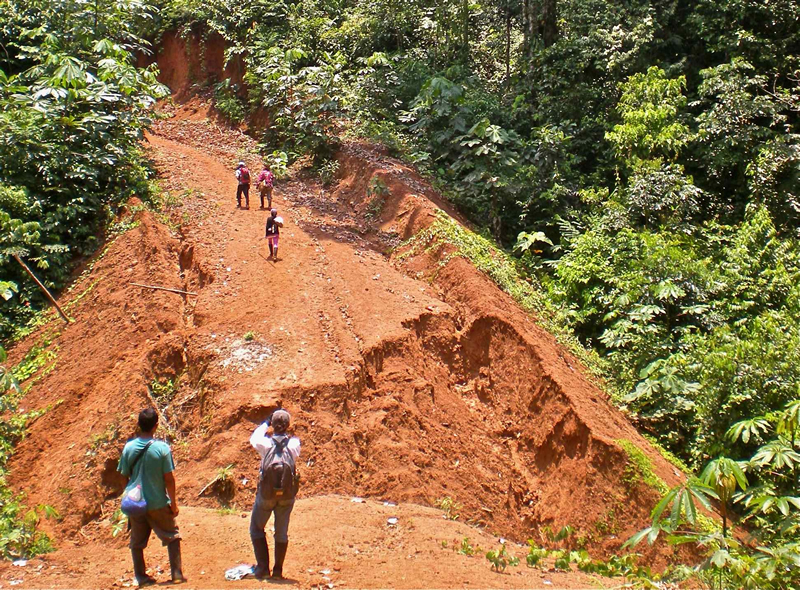
Stop an illegal road threatening the LAST Tropical Wet Forest on Earth, in Sumaco Biosphere Reserve, Ecuador
A rare rainforest ecosystem, is about to be pillaged….but not, if YOU help!?
Deep in an ancient wilderness in Ecuador…an illegal road threatens. Tractors are at this moment poised to tear down undiscovered canopy trees that have not yet even been named to science directly adjacent to the Napo-Galeras National Park. (The nucleus zone of maximum protection within UNESCO declared Sumaco Biosphere reserve.) The threatened are is a protected area called Patrimonio Forestal Wairachina Sacha, meaning “Forest Patrimony – Rainforest of the Purifying Winds, now legally protected under constitutional law.
The motives of the Regional Director of the Environment of Orellana province are unclear. Why would he compromise his name, by signing a document that violates Ecuador’s constitution, calling it a “neighborhood trail”, right through one of the last timber dense stands of virgin Tropical Wet Forest (TWF) left at that altitude in Ecuador and the world! This road will open a legally protected area to unregulated Illegal logging and cause an international outcry requesting the Ministry of the Environment step up to the table and follow the necessary measures that protect the UNESCO declared Sumaco Biosphere reserve. This means stopping the road where it is today at the village of Sumak Quichua, that it not go further into the protected area.
More about Wairachina Sacha, “Rainforest of the Purifying winds.” Despite its size (3,700 hect. – 9,143 acres) this area is:
1. The last opportunity in the entire world to protect a significant stand of disappearing Tropical Wet Forest, being encroached on all sides by development. This is a vanishing ecosystem type found only between 400-600 meters (elevation above sea level) that receives from 6-8 meters of rainfall per year! It is an area of immense value for its disproportionately high level of biological diversity. Scientific studies carried out by the Missouri Botanical Gardens have demonstrated the Sumaco biosphere reserve to be the epicenter of plant diversity on earth, and amidst the greater reserve, the narrow band of Tropical Wet Forest is the most vulnerable and threatened. The TWF has 27 species of endemic trees found in that narrow belt alone, not to mention over 300 species of canopy trees per hectare!
2. The last opportunity to protect the intact ecological gradient from 1750 meters above sea level to 350 meters above sea level, directly along the equator. Recent biological inventories show this forest to be the origin center of the chocolate tree family (Sterculeaceae), where large wild chocolate trees grow (Theobroma cacao).
3. The last chance to assist the local communities with an opportunity to turn Napo-Galeras National Park into a pole for sustainable development based on eco-tourism, being that this low land sector is critical for survival of endangered animal species (Andean spectacles Bear, Jaguar, Giant Armadillo, Giant Anteater, among others.) allows a natural access to the park, the road must be stopper at where it is now, at the edge of the forest area and threatens the ecological integrity of the area and damages ecotourism potential.
Given that the Patrimonio Forestal Wairachina Sacha is in immediate vicinity to Napo-Galeras National Park, and the small size that is Napo Galeras mountain (35,000 acres) and that the park boundaries begin at 800 meters elevation, the TWF east of Napo-Galeras is of transcendental value for the long term survival of all the endangered species that exist in the park that depend on these surrounding low land forests for their survival.
If completed, this illegal road that hugs the edge of the national park will cause the disappearance of the TWF, and severely erode the ecological integrity of the Napo-Galeras national park by allowing for rapid illegal logging of the giant (50 meters – 164 ft.) canopy trees that are there, such as kamotoa, a species in the Genus Gyanthera, that has yet to be given a species name and is on the verge of disappearance.
Stopping this illegal road represents is a critical opportunity for the cultural development that will allow for the true development of the local villagers based on sustainable alternatives, and to make a shift towards sustainable development, ecotourism, and sale of valuable products such as cacao, guayusa tea and other medicinal plants.

